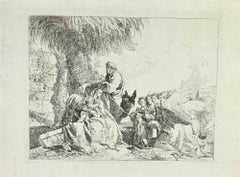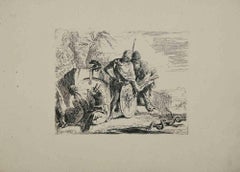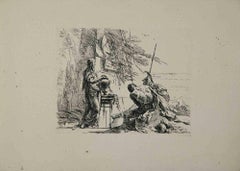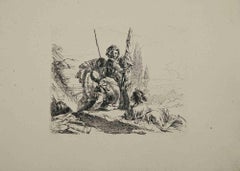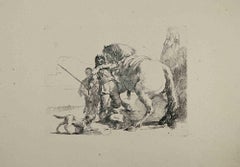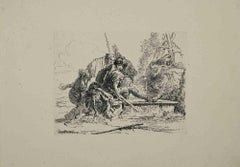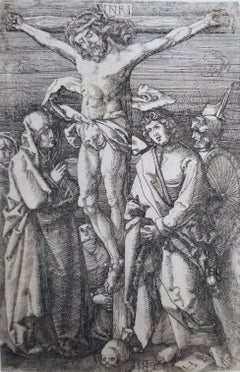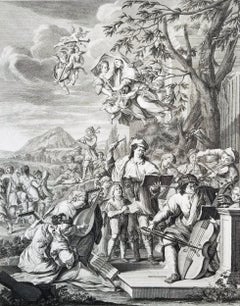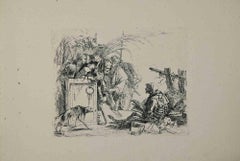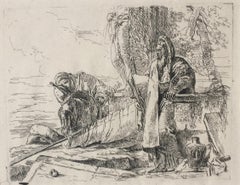Giovanni Battista Tiepolo Figurative Prints
to
10
Overall Width
to
Overall Height
to
10
10
830
375
361
308
10
10
5
5
10
8
6
5
4
2
2
1
1
10
8
Artist: Giovanni Battista Tiepolo
Rest on the Flight into Egypt - Etching by Giambattista Tiepolo - 1750
By Giovanni Battista Tiepolo
Located in Roma, IT
This etching on laid paper is the 13th plate of the series of 27 entitled Idee pittoresche sopra la fugga in Egitto di Giesù, Maria e Gioseppe executed by Giambattista Tiepolo and pu...
Category
1780s Old Masters Giovanni Battista Tiepolo Figurative Prints
Materials
Etching
Two Soldiers - Etching by G.B. Tiepolo - 1795
By Giovanni Battista Tiepolo
Located in Roma, IT
Two soldiers is an etching realized by Giambattista Tiepolo in 1785.
Sheet 23 x 30 cm.
Good impressions on paper, with wide margins.
Reference: D...
Category
1790s Old Masters Giovanni Battista Tiepolo Figurative Prints
Materials
Etching
Man and Soldier with an Urn - Etching by G.B. Tiepolo - 1785
By Giovanni Battista Tiepolo
Located in Roma, IT
Man and soldier with an urn is an etching realized by Giambattista Tiepolo in 1785.
A woman looks out of the print. Two characters, a man and a soldier, are in front of a funeral ...
Category
1780s Old Masters Giovanni Battista Tiepolo Figurative Prints
Materials
Etching
Two Soldiers - Etching by G.B. Tiepolo - 1785
By Giovanni Battista Tiepolo
Located in Roma, IT
Two soldiers is an etching realized by Giambattista Tiepolo, in 1785.
Sheet 23 x 30 cm.
Good impressions on paper, with wide margins.
Referenc...
Category
1780s Old Masters Giovanni Battista Tiepolo Figurative Prints
Materials
Etching
The Knight and his Horse - Etching by G.B. Tiepolo - 1785
By Giovanni Battista Tiepolo
Located in Roma, IT
The knight and his horse is an etching realized by Giambattista Tiepolo, in 1785.
Sheet 23 x 30 cm.
Good impressions on paper, with wide margin...
Category
1780s Old Masters Giovanni Battista Tiepolo Figurative Prints
Materials
Etching
Woman Soldiers - Etching by G.B. Tiepolo - 1785
By Giovanni Battista Tiepolo
Located in Roma, IT
Woman soldiers is an etching realized by Giambattista Tiepolo, in 1785.
Sheet 23 x 30 cm.
Good impression on paper, with wide margins.
Refere...
Category
1740s Old Masters Giovanni Battista Tiepolo Figurative Prints
Materials
Etching
The Young Man Sitting - Etching by G.B. Tiepolo - 1785
By Giovanni Battista Tiepolo
Located in Roma, IT
The young man sitting is an etching realized by Giambattista Tiepolo in 1785.
Sheet 23 x 30 cm.
Good impressions on paper, with wide margins.
...
Category
1740s Old Masters Giovanni Battista Tiepolo Figurative Prints
Materials
Etching
Chained Woman and Four Figures - Etching by G.B. Tiepolo - 1785
By Giovanni Battista Tiepolo
Located in Roma, IT
Chained woman and four figures is an etching realized by Giambattista Tiepolo, in 1785.
Sheet 32 X 23 CM.
Good impressions on paper, with wide margin...
Category
1740s Old Masters Giovanni Battista Tiepolo Figurative Prints
Materials
Etching
The Nynph and the Centaur - Etching by G.B. Tiepolo - 1785
By Giovanni Battista Tiepolo
Located in Roma, IT
The nynph and the centaur is an etching realized by Giambattista Tiepolo, in 1785.
Sheet 23 x 30 cm.
Good impression on paper, with wide margins.
Reference: De Vesme, 3/10; Rizzi 29...
Category
1740s Old Masters Giovanni Battista Tiepolo Figurative Prints
Materials
Etching
Philosopher Standing with Two Figures - Original Etching by G.B. Tiepolo
By Giovanni Battista Tiepolo
Located in Roma, IT
Extremely beautiful Artist's proof.
Sixth Sheet from “Vari Capricci”, the most important series by Giambattista Tiepolo including 10 etchings (un...
Category
1740s Old Masters Giovanni Battista Tiepolo Figurative Prints
Materials
Etching
Related Items
The Crucifixion (Christ on the Cross) /// Jesus after Albrecht Dürer Old Masters
Located in Saint Augustine, FL
Artist: Lambrecht Hopfer (German, Active c. 1525-1550)
Title: "The Crucifixion (Christ on the Cross)"
Portfolio: (after) The Engraved Passion
*Issued unsigned, though monogram signed by Hopfer in the plate (printed signature) lower right
Circa: 1530 (second state of three, published c. 1690)
Medium: Original Etching on laid paper
Limited edition: Unknown
Printer: The Hopfer family, Augsburg, Germany; (David Funck, Nuremberg, Germany)
Publisher: The Hopfer family, Augsburg, Germany; (David Funck, Nuremberg, Germany)
Reference: Bartsch No. VIII.527.12; Hollstein No. 12.II
Framing: Recently framed, the sheet is floated over, and top-matted with a 100% cotton fabric rag mat from Holland in a wood moulding and Museum glass
Framed size: 14.88" x 13.88"
Sheet size: 5.5" x 3.63"
Condition: Trimmed to platemark. A few tiny professional repairs: at elbow of Jesus's right arm and the inside thigh of Jesus. Some light skinning upper right corner and lower right area. It is otherwise a strong impression in good condition
Very rare
Notes:
Provenance: private collection - Green Bay, WI; acquired from Sotheby's, New York, NY in c. 2015. The artist Lambrecht Hopfer's printed monogram signature "LH" lower right. The printer/publisher David Funck's (plate) number "182" lower right. This etching is after Albrecht Dürer’s 1511 engraving "The Crucifixion (Christ on the Cross)", ("Dürer-Katalog" - Meder No. 13, page 73). Printed in black from an iron plate. The image depicts Christ on the cross at center, the Virgin at left, two Maries behind her, St. John standing at right, a Roman solider behind him. It is after the eleventh plate of Dürer's sixteen plates from his 1507-1513 "The Engraved Passion" series, ("Dürer-Katalog" - Meder No. 3-18, page 70-74).
"The print was originally designed without the number engraved in the lower margin (First state: Lambrecht Hopfer, c. 1530). The Hopfers' descendant David Funck (Nuremberg, 1642–1705) acquired over two hundred of their original iron plates, engraved numbers into them, and re-printed them around 1686-1700. The "182" indicates that "The Crucifixion" was the 182nd print in Funck’s series (Second state: David Funck, c. 1686-1700). About a century later, 92 of these plates were acquired by Carl Wilhelm Silberberg in Frankfurt and printed for the third and final time in the book "Opera Hopferiana", of which "The Crucifixion" was the 90th print (Third state: Carl Wilhelm Silberberg for "Opera Hopferiana", 1802)". - Elizabeth Upper, Cambridge University Library, University of Cambridge, Cambridge, UK
Biography:
Lambrecht (Lambert) Hopfer (Active c. 1525-1550) was a German Old Masters printmaker. He was the brother of Hieronymus Hopfer (Active c. 1520-1530) and son of Daniel Hopfer...
Category
16th Century Old Masters Giovanni Battista Tiepolo Figurative Prints
Materials
Etching, Laid Paper
Vespera; Der Abend (Evening; The Evening) /// Johann Daniel Preissler Old Master
Located in Saint Augustine, FL
Artist: (after) Johann Daniel Preissler (German, 1666-1737)
Title: "Vespera; Der Abend (Evening; The Evening)"
Portfolio: Die Vier Tageszeiten (The Four Times of Day)
Year: 1723
Medium: Original Etching and Engraving on laid paper
Limited edition: Unknown
Printer: likely Johann Balthasar Probst, Augsburg, Germany
Publisher: Jeremias Wolff (Erben), Augsburg, Germany
Reference: Le Blanc No. 255, 38; Nagler No. 23
Sheet size: 22.5" x 16.63"
Image size: 17.38" x 13.63"
Condition: Soft handling creases and folds to sheet. Some scattered foxmarks in left margin. Two small tears skillfully repaired from verso in margins. Has been professionally stored away for decades. It is otherwise a strong impression in good condition with full margins
Extremely rare
Notes:
Provenance: private collection - Aspen, CO. Engraved by German artist Johann Balthasar Probst (1673-1750) after a drawing by German artist Johann Daniel Preissler (1666-1737). Comes from Preissler's 1723 "Die Vier Tageszeiten (The Four Times of Day)" portfolio of four etchings and engravings. Printed from one copper plate in one color: black. Descriptions of the portrayed image are printed in Latin and German.
Biography:
Johann Daniel Preissler, or Preisler (1666–1737) was a German painter and director of Nuremberg's Academy of Fine Arts. He was a notable member of a German artistic family, originating in Bohemia. His children included Johann Justin Preissler (1698–1771), Georg Martin Preisler (1700–1754), Barbara Helena Preisler (1707–1758; married to Oeding), Johan Martin Preisler (1715–1794), and Valentin Daniel Preisler (1717–1765), all in their time renowned artists. Most notable for his portraits, nudes and history paintings, Johann Daniel Preissler also produced drawings and frescoes. He was particularly known beyond his native Nuremberg for his "Die durch Theorie erfundene Practic", a sequence of works on art theory – the individual works were translated into several other languages and served as textbooks for students such as the Swiss Salomon Gessner...
Category
1720s Old Masters Giovanni Battista Tiepolo Figurative Prints
Materials
Laid Paper, Engraving, Etching
$900
H 22.5 in W 16.63 in
Meridies; Der Mittag (Noon; The Midday) /// Johann Daniel Preissler Old Master
Located in Saint Augustine, FL
Artist: (after) Johann Daniel Preissler (German, 1666-1737)
Title: "Meridies; Der Mittag (Noon; The Midday)"
Portfolio: Die Vier Tageszeiten (The Four Times of Day)
Year: 1723
Medium: Original Etching and Engraving on laid paper
Limited edition: Unknown
Printer: likely Johann Balthasar Probst, Augsburg, Germany
Publisher: Jeremias Wolff (Erben), Augsburg, Germany
Reference: Le Blanc No. 255, 38; Nagler No. 23
Sheet size: 22.5" x 16.32"
Image size: 18.13" x 14.32"
Condition: Soft handling creases and folds to sheet. A few light areas of staining and scattered small areas of discoloration in margins. Two small tears skillfully repaired from verso in margins. Has been professionally stored away for decades. It is otherwise a strong impression in good condition with full margins
Extremely rare
Notes:
Provenance: private collection - Aspen, CO. Engraved by German artist Johann Balthasar Probst (1673-1750) after a drawing by German artist Johann Daniel Preissler (1666-1737). Comes from Preissler's 1723 "Die Vier Tageszeiten (The Four Times of Day)" portfolio of four etchings and engravings. Printed from one copper plate in one color: black. Descriptions of the portrayed image are printed in Latin and German.
Biography:
Johann Daniel Preissler, or Preisler (1666–1737) was a German painter and director of Nuremberg's Academy of Fine Arts. He was a notable member of a German artistic family, originating in Bohemia. His children included Johann Justin Preissler (1698–1771), Georg Martin Preisler (1700–1754), Barbara Helena Preisler (1707–1758; married to Oeding), Johan Martin Preisler (1715–1794), and Valentin Daniel Preisler (1717–1765), all in their time renowned artists. Most notable for his portraits, nudes and history paintings, Johann Daniel Preissler also produced drawings and frescoes. He was particularly known beyond his native Nuremberg for his "Die durch Theorie erfundene Practic", a sequence of works on art theory – the individual works were translated into several other languages and served as textbooks for students such as the Swiss Salomon Gessner...
Category
1720s Old Masters Giovanni Battista Tiepolo Figurative Prints
Materials
Laid Paper, Engraving, Etching
$900
H 22.5 in W 16.32 in
Aurora sive Tempus Matutinum; Der Wohl und Übel angewandte Morgen /// Old Master
Located in Saint Augustine, FL
Artist: (after) Johann Daniel Preissler (German, 1666-1737)
Title: "Aurora sive Tempus Matutinum; Der Wohl und Übel angewandte Morgen (Dawn or Morning Time; The Morning Used for Better or For Worse)"
Portfolio: Die Vier Tageszeiten (The Four Times of Day)
Year: 1723
Medium: Original Etching and Engraving on laid paper
Limited edition: Unknown
Printer: likely Johann Balthasar Probst, Augsburg, Germany
Publisher: Jeremias Wolff (Erben), Augsburg, Germany
Reference: Le Blanc No. 255, 38; Nagler No. 23
Sheet size: 22.57" x 16.38"
Image size: 17.75" x 14"
Condition: Soft handling creases, folds, and scattered faint areas of discoloration to sheet. Three tears skillfully repaired from verso. Has been professionally stored away for decades. It is otherwise a strong impression in good condition with full margins
Extremely rare
Notes:
Provenance: private collection - Aspen, CO. Engraved by German artist Johann Balthasar Probst (1673-1750) after a drawing by German artist Johann Daniel Preissler (1666-1737). Comes from Preissler's 1723 "Die Vier Tageszeiten (The Four Times of Day)" portfolio of four etchings and engravings. Printed from one copper plate in one color: black. Descriptions of the portrayed image are printed in Latin and German.
Biography:
Johann Daniel Preissler, or Preisler (1666–1737) was a German painter and director of Nuremberg's Academy of Fine Arts. He was a notable member of a German artistic family, originating in Bohemia. His children included Johann Justin Preissler (1698–1771), Georg Martin Preisler (1700–1754), Barbara Helena Preisler (1707–1758; married to Oeding), Johan Martin Preisler (1715–1794), and Valentin Daniel Preisler (1717–1765), all in their time renowned artists. Most notable for his portraits, nudes and history paintings, Johann Daniel Preissler also produced drawings and frescoes. He was particularly known beyond his native Nuremberg for his "Die durch Theorie erfundene Practic", a sequence of works on art theory – the individual works were translated into several other languages and served as textbooks for students such as the Swiss Salomon Gessner...
Category
1720s Old Masters Giovanni Battista Tiepolo Figurative Prints
Materials
Laid Paper, Engraving, Etching
$900
H 22.57 in W 16.38 in
The New Testament /// Old Masters Biblical Religious Engraving Dutch Angel Art
By Michael Burghers
Located in Saint Augustine, FL
Artist: Michael Burghers (Dutch, c.1647/1648-1727)
Title: "The New Testament"
Portfolio: Holy Bible
*Signed by Burghers in the plate (printed signature) lower left
Year: 1680
Medium: Original Etching and Engraving with recent Hand-Color on watermarked laid paper
Limited edition: Unknown
Printer: John Baskett, London?, UK
Publisher: Moses Pitt, Peter Parker, and Thomas Guy, London?, UK
Sheet size (irregular margins): 17.25" x 10.5"
Image size: 14.75" x 9.5"
Condition: Uneven trimming and light edgewear in margins. One small tear entering image lower right which has been skillfully repaired with added backing paper with archival tape from verso. It is otherwise a strong impression in very good condition with strong colors
Very rare
Notes:
Provenance: private collection - Cotswolds, UK. Comes from the 1685 "Holy Bible" portfolio. John Baskett was deemed printer to the King's most Excellent Majesty, for Great Britain and to the University of Oxford. Large unidentified watermark within center of sheet. There is an example of this work in the permanent collection of the British Museum in London, UK.
In the foreground, John the Evangelist, holding a pen and writing...
Category
1680s Old Masters Giovanni Battista Tiepolo Figurative Prints
Materials
Watercolor, Engraving, Etching, Laid Paper, Intaglio
Michael BurghersThe New Testament /// Old Masters Biblical Religious Engraving Dutch Angel Art, 1680
$1,200 Sale Price
45% Off
H 17.25 in W 10.5 in
Piquier Allemand (German Pikeman) /// Old Masters Figurative Man Soldier Antique
Located in Saint Augustine, FL
Artist: Armand Joseph Lallemand (French, 1810-1871)
Title: "Piquier Allemand (German Pikeman)"
Portfolio: Gazette des Beaux-Arts
Year: 1866
Medium: Original Etching on cream laid pap...
Category
1860s Old Masters Giovanni Battista Tiepolo Figurative Prints
Materials
Laid Paper, Etching, Intaglio
Set of Two Engravings after Cipriani "Four Muses" & "Father and Two Daughters"
By Francesco Bartolozzi
Located in Saint Augustine, FL
Artist: Francesco Bartolozzi (Italian, 1727-1815)
Title: "Four Muses" & "Father and Two Daughters"
Portfolio: Rudiments of Drawing
*Issued unsigned, though both are signed by Bartolo...
Category
1780s Old Masters Giovanni Battista Tiepolo Figurative Prints
Materials
Engraving, Etching
Basilica of San Lorenzo in Rome: A Framed 18th Century Etching by Piranesi
By Giovanni Battista Piranesi
Located in Alamo, CA
This large framed 18th century etching by Giovanni Battista Piranesi entitled "Veduta della Basilica di S. Lorenzo fuor della mura" (Basilica of San Lorenzo Outside the Walls), published in Rome in 1750 in Piranesi's Vedute di Roma (Views of Rome), This etching depicts the Basilica of San Lorenzo Outside the Walls, which is a Roman Catholic papal basilica and parish church, located in Rome, Italy. The Basilica is one of the Seven Pilgrim Churches of Rome and one of the five "papal basilicas". It was built as a shrine to the martyred Roman deacon St. Lawrence.
This Piranesi etching is held by many museums and institutions, including: The Metropolitan Museum, The British Museum, The National Gallery of Art, The Yale University Art Gallery, and The Harvard Museum of Art.
This magnificent etching is presented in a brown-colored wood frame and a tan French...
Category
1750s Old Masters Giovanni Battista Tiepolo Figurative Prints
Materials
Etching
$2,975
H 23.13 in W 33 in D 0.5 in
Crucifixion: 18th Century Etching by Conrad Metz after Daniele da Volterra
Located in Alamo, CA
"Crucifixion" is an etching and aquatint, printed in brown ink by Conrad M. Metz after a painting by Daniele da Volterra. It was published in London in 1789 in 'Imitations Of Ancient...
Category
Late 18th Century Old Masters Giovanni Battista Tiepolo Figurative Prints
Materials
Etching, Aquatint
$975
H 17 in W 11.75 in
Hadrian's Mausoleum, Castel S. Angelo: A Framed 18th Century Etching by Piranesi
By Giovanni Battista Piranesi
Located in Alamo, CA
This large framed 18th century etching by Giovanni Battista Piranesi entitled "Veduta del Mausoleo d'Elio Adriana ora chiamato Castello S. Angelo nella parte opposta alla Facciata de...
Category
1750s Old Masters Giovanni Battista Tiepolo Figurative Prints
Materials
Etching
$5,875
H 28.88 in W 37.25 in D 1.25 in
Church of St. Costanza, Rome: An 18th Century Piranesi Architectural Etching
By Giovanni Battista Piranesi
Located in Alamo, CA
This is a framed 18th century Giovanni Battista Piranesi etching entitled: "Veduta interna del Sepocro di Santa Costanza, fabbricat...
Category
1770s Old Masters Giovanni Battista Tiepolo Figurative Prints
Materials
Etching
$3,775
H 27 in W 32 in D 1.5 in
A Framed 18th C. Piranesi Etching of an Ancient Marble Vase from Hadrian's Villa
By Giovanni Battista Piranesi
Located in Alamo, CA
This large framed 18th century etching by Giovanni Battista Piranesi is entitled "Vaso antico di Marmo adornato di eccellenti Sculture si nella parte anteriere che nell' opposta, le ...
Category
1770s Old Masters Giovanni Battista Tiepolo Figurative Prints
Materials
Etching
$3,975
H 42.25 in W 26.5 in D 1.5 in
Previously Available Items
Death Holds an Audience - Etching by G.B. Tiepolo - 1785
By Giovanni Battista Tiepolo
Located in Roma, IT
Death holds an audience is an etching realized by Giambattista Tiepolo in 1785.
Death, an old nun with a veiled head leafs through a large book and holds an audience. In front of ...
Category
1780s Old Masters Giovanni Battista Tiepolo Figurative Prints
Materials
Etching
H 9.06 in W 12.6 in D 0.04 in
THE STANDING PHILOSOPHER
By Giovanni Battista Tiepolo
Located in Santa Monica, CA
GIOVANNI B. TIEPPLO (1696- 1770)
FILISOFO IN PIEDI E DUE FIGURE (THE STANDING PHILOSOPHER) (DeVesme 8, Rizzzi 34)
Etching before 1749. 5 ¼” x 6 7/8” - wide ma...
Category
1740s Old Masters Giovanni Battista Tiepolo Figurative Prints
Materials
Etching
Ninfa con Piccolo Satiro e Due Capre
By Giovanni Battista Tiepolo
Located in Roma, IT
Black and white etching on wire rod paper. Signed on plate on the lower left margin, printed in a unique state and belonging to the series “Varj Capricci”.
Very fine impression with ...
Category
Early 18th Century Old Masters Giovanni Battista Tiepolo Figurative Prints
Materials
Etching
L'Astrologo e il Giovane Soldato
By Giovanni Battista Tiepolo
Located in Roma, IT
Black and white etching on wire rod paper. Signed on plate on the lower right margin, printed in a unique state and belonging to the series “Varj Capricci”.
Excellent impression with...
Category
18th Century Old Masters Giovanni Battista Tiepolo Figurative Prints
Materials
Etching
La Morte dà Udienza
By Giovanni Battista Tiepolo
Located in Roma, IT
Black and white etching on wire rod paper. Signed on plate on the lower left margin (under the dog). Printed in a unique state. Plate from the series “Varj Capricci” by Giambattista ...
Category
18th Century Old Masters Giovanni Battista Tiepolo Figurative Prints
Materials
Etching
Giovanni Battista Tiepolo figurative prints for sale on 1stDibs.
Find a wide variety of authentic Giovanni Battista Tiepolo figurative prints available for sale on 1stDibs. You can also browse by medium to find art by Giovanni Battista Tiepolo in etching and more. Much of the original work by this artist or collective was created during the 18th century and is mostly associated with the Old Masters style. Not every interior allows for large Giovanni Battista Tiepolo figurative prints, so small editions measuring 10 inches across are available. Customers who are interested in this artist might also find the work of Jacques Callot, Cornelis Bega, and Adriaen van Ostade. Giovanni Battista Tiepolo figurative prints prices can differ depending upon medium, time period and other attributes. On 1stDibs, the price for these items starts at $2,661 and tops out at $3,788, while the average work can sell for $2,883.
Artists Similar to Giovanni Battista Tiepolo
Questions About Giovanni Battista Tiepolo Figurative Prints
- 1stDibs ExpertJanuary 10, 2025Giovanni Battista Piranesi is famous for his work spanning many different fields. After a slow start, he eventually achieved great success as an architect, archaeologist, artist, designer, collector and antiquities dealer. His mission was to glorify the architecture of ancient Rome through his engravings and etchings. His highly dramatized prints often depict imaginary interiors and frequently include figures in mysterious activities who are dwarfed by the magnitude of their monumental surroundings. Piranesi's style greatly influenced the neoclassical art movement of the late 18th century. Explore a collection of Giovanni Battista Piranesi art on 1stDibs.
